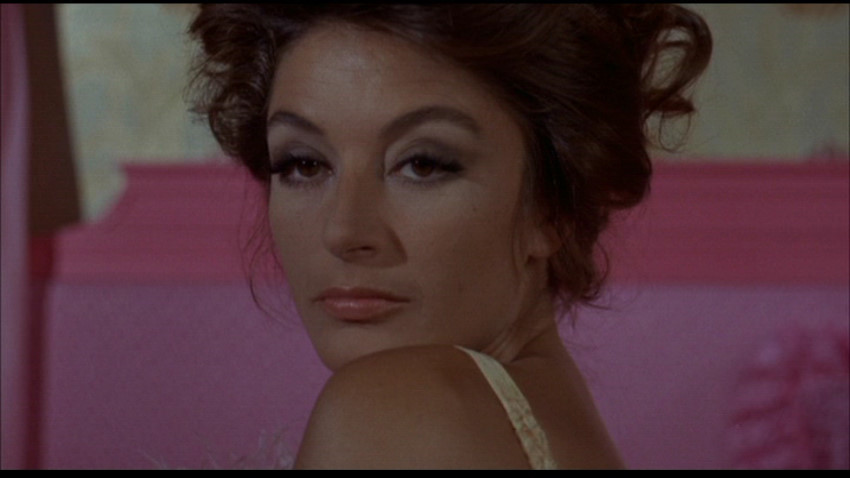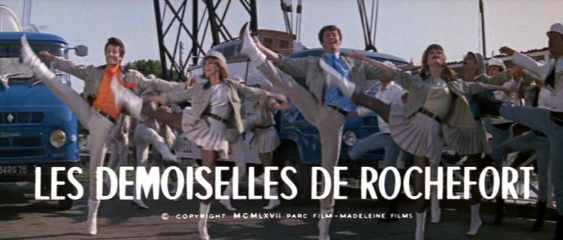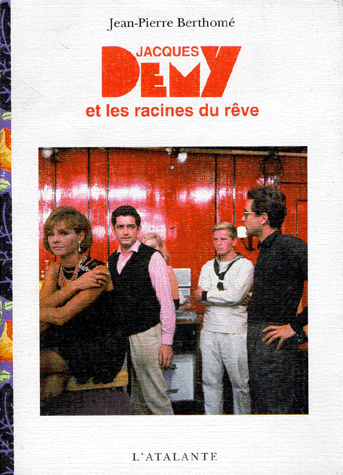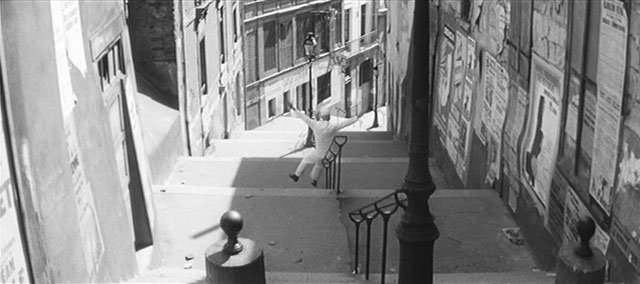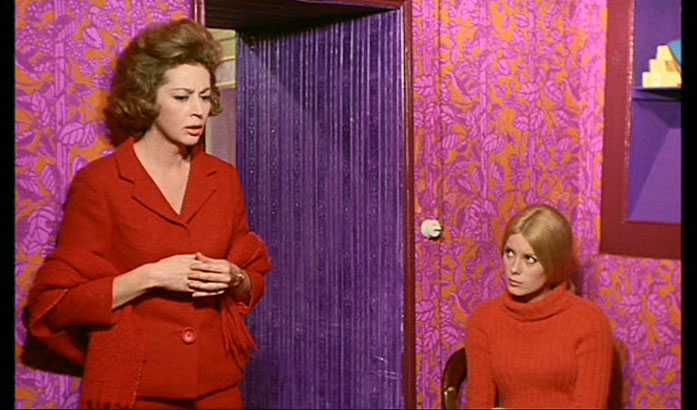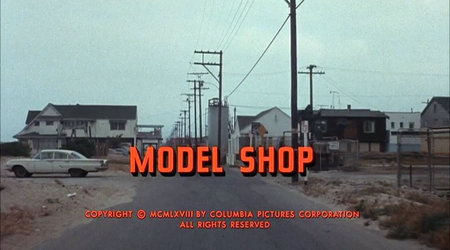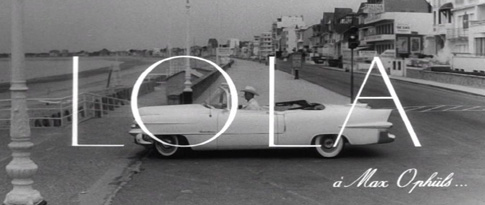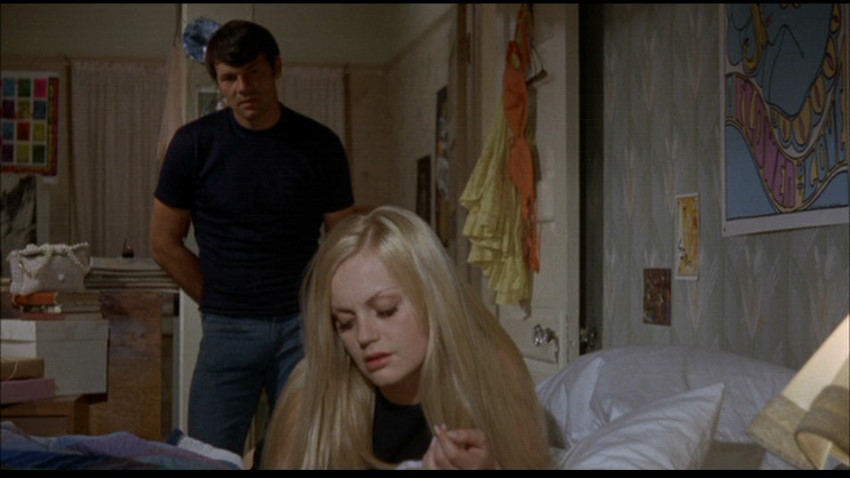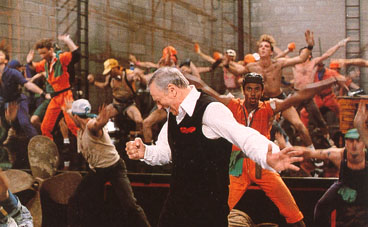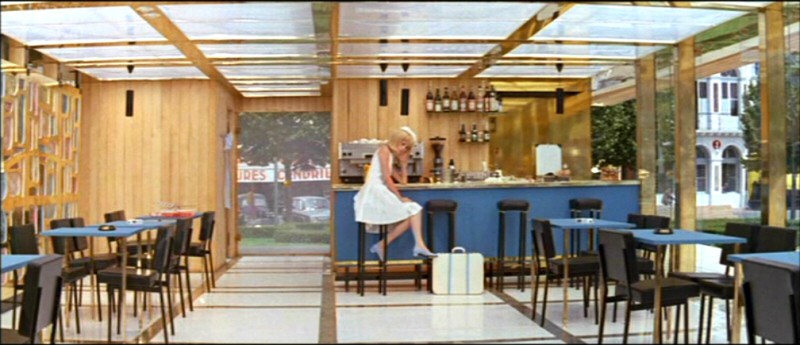Written for a retrospective catalog devoted to Jacques Demy, published by the San Sebastian International Film Festival, September 15-24, 2011, and reprinted in my book Cinematic Encounters 2: Portraits and Polemics (2019). — J.R.
“Braque, Picasso, Klee, Miro, Matisse….C’est ça, la vie.”–- Maxence in Les Demoiselles de Rochefort
“Life is disappointing, isn’t it?”
–- Kyoko in Tokyo Story
1
I’ve never come across any critical discussion of common traits in the separate films of Jacques Demy and Agnès Varda, who lived together for three decades. Their oeuvres are in fact quite different and distinct from one another, but one striking characteristic they share as filmmakers is their preoccupation with indexing and cross-referencing their own works within their own films.
In chronicling and excerpting her own previous work, Varda’s Les Plages d’Agnès (2008) brings this tendency to a climax, but her DVD containing Les Glaneurs et la Glaneuse (2000) and its sequel, Deux Ans Après, already formalizes and optimizes this tendency — which can be traced within and between some of her previous films — by allowing one to leap via one’s remote control from a character in the former documentary to the same person being filmed two years later (or vice versa). In a comparable spirit, Demy transplants Cécile/Lola (Anouk Aimée), the title heroine of his first feature (1960), from Nantes to Los Angeles in his fifth feature, Model Shop (1968), after having had her killed offscreen in Rochefort in his fourth feature, Les Demoiselles de Rochefort (1966). In Model Shop, he also has Lola explain that Michel (Jacques Harden), her long-lost boyfriend who returned for her at the end of Lola, eventually abandoned her to run off with Jacqueline Demestre (Jeanne Moreau), the heroine of Demy’s second feature, La Baie des anges (1962). Meanwhile, Roland Cassard (Marc Michel), the young man in Nantes who fell in love with Lola before leaving for Johannesburg, re-emerged in Cherbourg in Les Parapluies de Cherbourg (1964), Demy’s third feature, as a successful diamond merchant to marry the pregnant and abandoned Geneviève (Catherine Deneuve), the heroine of that film.
Bearing this common trait in mind, Varda’s wonderful documentary L’univers de Jacques Demy (1993) manages to cross-index her late husband’s work in many effective ways — cutting directly, for instance, from the father-daughter incest in Demy’s final feature, Trois places pour le 26 (1988) to the father-daughter incest in his earlier Peau d’Âne (1970), or cutting between a suspension bridge remembered in Demy’s childhood to several bridges of this kind in his films (e.g., the credits sequence of Les Demoiselles de Rochefort, the backdrop of some dance performances in Trois places pour le 26) –- and also cross-references his work with her own (as well as with their separate and their interconnected lives) in many other ways.
Part of the point of stressing all these interconnections is the fact that Demy (like Varda), in spite of all the frustrations and economic imperatives that frequently interfered with his plans – and indeed, perhaps in part because of them — has to be seen as the author of an oeuvre, not simply as the author of individual films (and one, moreover, who assumed sole screenwriting credit on most of them). The iris shots that end both his first feature, Lola, and his last, Trois places pour le 26, is echoed fairly precisely by the iris shot that opens his second feature, La Baie des anges; and the blazing colors of the wallpaper in his third feature, Les Parapluies de Cherbourg, are already anticipated in the blazing red wallpaper of the only set in his short film Le Bel Indifférent (1957), made three years before Lola.
We know, of course, from the superb documentation of Jean-Pierre Berthomé’s Jacques Demy ou les racines du rêve (Nantes: L’Atalante, seconde édition, 1996), that Demy rarely (if ever) got the opportunity to make his films according to his original conceptions. In the case of Le Bel Indifférent, he would have preferred to have adapted Cocteau’s La Voix humaine; Lola was conceived as a Michel Legrand musical, and he had to dispense with color and (for the most part) songs when his budgetary restrictions made this impossible; he wanted to cast Nino Castelnuovo, the male lead of Cherbourg, in Rochefort, until he had to rewrite the script and assign this part to Grover Dale; and comparable revisions of this kind can be found throughout his filmography. Yet at the same time, the autobiographical elements that got worked into his scripts and projects are equally constant, accounting for everything from the garage in Cherbourg (inspired by the one where his father worked in Nantes) to the aforementioned suspension bridges.
2
To broach the issue of how Jacques Demy is misunderstood and misperceived in English-speaking countries, one should go to the English-language version of Wikipedia, The Free Encyclopedia (at wikipedia.com), where the second sentence of the entry on Demy comes close to summarizing many of the major misunderstandings and historical confusions:
Jacques Demy (5 June 1931 – 27 October 1990) was one of the most approachable filmmakers to appear in the wake of the French New Wave. Uninterested in the formal experimentation of Alain Resnais, or the political agitation of Jean-Luc Godard, Demy instead created a self-contained fantasy world closer to that of François Truffaut, drawing on musicals, fairytales and the golden age of Hollywood. [2020 postscript: This Wikipedia entry has subsequently been substantially revised.]
At the beginning of the respective careers of Demy, Godard, Resnais, and Truffaut, one might counter that certain signs of “political agitation” came from Resnais as well as Godard (in Le Petit Soldat) — a trait especially apparent in Resnais’ first major short film, Les Statues meurent aussi (1953), an essay about African sculpture made in collaboration with writer Chris Marker and cinematographer Ghislain Cloquet, an essay film whose attacks on racism and colonialist appropriation in its final reel led to the film being banned for almost half a century. Moreover, all four of these directors, along with Jacques Rivette, clearly had some interest in formal experimentation, and in the case of Demy, this interest had a great deal to do with confronting “musicals, fairytales” and “the golden age of Hollywood” with the real world, including such real cities as Cherbourg, Los Angeles, Monte Carlo, Nantes, and Rochefort — a confrontation, moreover, that had (and still has) many political ramifications.
So one way of perpetuating the historical misunderstandings and confusions found in these two sentences would be to assume, as this Wikipedia entry does, that “formal experimentation” and “political agitation” are necessarily alternative paths to take in filmmaking rather than, at least in certain cases, as two manifestations of the same impulse, and that the creation of “a self-contained fantasy world” that is misleadingly attributed here to both Truffaut and Demy represents a third path. Yet the moment one starts to consider what could be meant by “self-contained fantasy world[s]” in the early features of Demy and Truffaut, one would presumably also have to include such themes as parental neglect (Les 400 Coups), World War I (Jules et Jim and La Chambre Verte), the plight of a single mother (Lola), the French war in Algeria (Les Parapluies de Cherbourg), the U.S. war in Vietnam (Model Shop), and a shipyard labor strike (Une Chambre en ville) as parts of the presumed “unreality” of these fantasies — along with the unorthodox and unstable genre mixes of, say, Tirez sur la pianiste and Les Demoiselles de Rochefort.
Most musicals shift back and forth between story (spoken dialogue) and song-and-dance numbers — sometimes creating queasy transitions just before or after these shifts, when we’re uncertain where we are stylistically. But Les Demoiselles de Rochefort often daringly places story and musical numbers on the screen simultaneously, mixing them in various ways and in different proportions, which wittingly or unwittingly produces a certain malaise, or at least a certain amount of disquiet or discomfort, along with some exhilaration. (Two freakish American musicals of the 1930s, Love Me Tonight and Hallelujah, I’m a Bum, display a related metaphysical impulse to perceive the musical form as a continuous state of delirious being rather than a traditional story with musical eruptions, with comparably unstable results.) One of the stars may be simply walking down the street, for example, while many or all of the pedestrians around her are dancing, and she can be seen slipping momentarily in and out of their choreography. The feeling of uncertainty or instability arising from this mixture produces powerful and deeply felt yet conflicted emotions — exuberance combined with confusion or a sense of absurdity, a kind of transport underlined or at least threatened by an almost constant sense of loss, yearning, and even tragedy. All of which makes it explicable why both Rochefort and the 30s musicals just cited failed at the box office in the U.S., and why Trois places — which contains similar moments of uneasy transition in relation to its choreography — has never received a commercial run there. (By way of contrast, the commercial success of Cherbourg in America can probably be explained in part by the continuous use of song and the absence of choreography, both of which result in an avoidance of the kind of instability I’ve been describing.)
3
I suspect that the problems being broached here are ultimately philosophical ones — specifically, the empiricism of Anglo-American culture trying to make sense of some of the Cartesian underpinnings of French culture. For me, one way of expressing the philosophical paradoxes of Demy’s films would be to say, “ I think, therefore I am, and dreaming is a part of thought, therefore a part of life and existence; ergo, I dream, therefore I exist.” Or, more simply, “I dream, therefore I live.” Consequently, the impressions of both artificiality and of actuality in Demy’s work can be highly deceptive: the use of “natural” locations that have been freshly repainted (as in Cherbourg and Rochefort), the supposed simplicities of fairy tales and “innocent” Hollywood genres complicated by such things as incest (in Peau d’Âne and Trois Places pour le 26) and an ax murder (in Rochefort). Serge Daney once aptly described Une chambre en ville as Bizet’s Carmen revisited by Visconti, and it is important to bear in mind that operatic and melodramatic modes are as pertinent to Demy’s art as cinematic ones. (Significantly, he often recalled that his formative filmgoing experience as a child was Les Dames du Bois de Boulogne.)
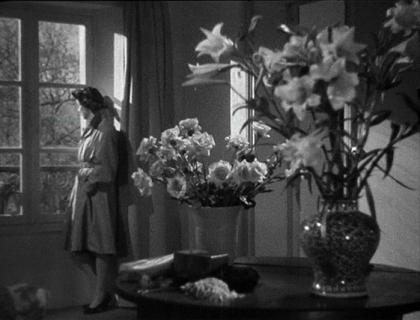
A somewhat different spin on this position can be found in a famous statement of the Irish poet William Butler Yeats: “In dreams begin responsibilities.” And what responsibilities are these, in the case of Demy? Among others, formal and political ones. The formal responsibilities include his uses of“musicals, fairytales and the golden age of Hollywood,” along with operas and melodramas, and the political responsibilities include his considerations of the “real,” the world of the everyday as it brushes part or collides with these various modes of fiction and artifice.
For Pauline Kael, writing about Model Shop (in The New Yorker, February 22, 1969), Demy’s first film in English, about Los Angeles, commits the fatal flaw of treating its setting and characters realistically after he excelled as a master of movie-based fantasy in Lola, La Baie des Anges, and Les Parapluies de Cherbourg, and, according to Kael, “misunderstood” the conventions of Hollywood musicals in Les Demoiselles de Rochefort. But I believe it’s a serious error to assume that any of Demy’s features can be classified quite so simply or unambiguously, which can only be done by overlooking the complex mixtures that inform his work at virtually every moment. Even the forays in his work that appear to come closest to “pure” actuality or artifice, such as the Los Angeles of Model Shop or the fairy-tale trappings of Peau d’Âne, are contradictory portraits, especially if one considers all the coincidental and chance elements of the former and the conscious anachronisms (such as the hash pipe and the helicopter) in the latter.
By comparing Demy with three other filmmakers — Yasujiro Ozu, Frank Tashlin, and Jean-Luc Godard, all of them quite dissimilar to one another — I would like to suggest that what we generally mean by such terms as “fantasy” and “reality” are invariably grounded in alternative sets of film conventions that need to be defined as such. While Ozu, for instance, is commonly regarded as a “realistic” chronicler of everyday life in Japan, the critic Shigehiko Hasumi has adroitly demonstrated how even the weather in most Ozu films, all of them set in Japan, is the sunny weather of southern California –- as perceived by Ozu through his career-long absorption in and fascination with Hollywood films -– rather than the rainier weather of Japan. Similarly, one could argue that even the more “realistic” employments of French locations and social mores in Demy’s first four features are informed and inflected by various film traditions (such as those deriving from Bresson, Cocteau, Ophüls, and various musicals from Hollywood and elsewhere), so that Hollywood and other forms of commercial filmmaking serve to shape as well as filter many of the “realistic” details.
A famous line uttered in Ozu’s Tokyo Story – “Life is disappointing, isn’t it?” -– could serve as a virtual motto to Lola and Les Parapluies de Cherbourg, and it is worth adding that Demy is every bit as preoccupied as Ozu with the formulas, ceremonies, and rituals of everyday life — not only rituals such as getting married, going off to war, having children, and losing or finding work, but also such minor rituals as saying “Good morning” and “Thank you” — with the full span of generations and age groups informing the social interactions of particular neighborhoods and their hangouts (mainly cafés) as well as the dynamics of family life. One of Ozu’s sublime late films, Good Morning, is very much concerned with that particular salutation — as is Cherbourg, which has more than its share of bonjours, each one musically placed. It may say something about the difference between Japan and France–as well as the difference between Ozu and Demy as artists – that Ozu’s films are full of father figures and Demy’s are more often bereft of them (with a few exceptions in the latter portion of his career). But their views of the human condition are surprisingly similar.
By contrast, the similarity of Demy to Frank Tashlin is relatively limited — circumscribed by the fact that both directors entered film via animation and that both had a special taste for “loud” primary colors — and one should emphasize that their differences are just as relevant. Tashlin’s satirical mode, to begin with, was almost entirely foreign to Demy. When the latter charts in Cherbourg with withering accuracy the steps that Geneviève’s mother takes to snare the diamond merchant — a process that begins even before she discovers that Geneviève is pregnant – he doesn’t view the process satirically or even judgmentally; he’s simply observing in detail the way French people behave in such situations, with a kind of accuracy and fidelity that seems comparable to that of Ozu in chronicling the behavior in his own country.
The dialectical play between documentary and fantasy in Godard seems far more relevant, especially as it figures in a film such as Alphaville. Indeed, the two features of Demy that to my mind have been most critically underrated and neglected are arguably the ones in which the play between actuality and artifice is the most complex and unconventional, Model Shop and Trios places pour le 26. The nature of both the realities and the contrivances that figure in each film, I should add, is quite different, and these films need to be considered separately.
In Model Shop, one should consider first of all a portrait of everyday life Los Angeles in 1969, particularly in relation to the counterculture of that period, that seems remarkably accurate and authentic (especially if one compares the film to Antonioni’s relatively expressionistic depiction of Los Angeles in Zabriskie Point a year later), placed inside a “drifting” narrative that unfolds over a few hours that is essentially framed by the hero (Gary Lockwood) driving around, attempting to borrow money to prevent his car from being repossessed, his chance encounter with and pursuit of a French model (Anouk Aimée), the discovery during a phone call to his parents that a draft notice has been sent to him in San Francisco, and his eventual breakup with his girlfriend (Alexandra Hay) back at their bungalow. This narrative material — which is paradoxically both action-packed and, in terms of most Hollywood conventions, devoid of incident, and in which the sprawling topography of Los Angeles figures as a constant documentary presence – plays against contrary elements that can be characterized as “auteurist”: a very contrived and artificial back story bringing together diverse characters from Demy’s first three features (which I’ve already described in the second paragraph of this essay) as well as an employment of the film’s title location as a self-referential device that addresses Demy’s own activity as a “photographer” and director. (One should also cite the use of film stills from both Lola and Godard’s A bout de souffle, two low-budget Nouvelle Vague features sharing the same producer and cinematographer; in a similar spirit, Lola employs a still of Elina Labourdette from Les Dames du Bois de Boulogne to represent her character’s past as a dancer.)
In Trois places pour le 26, one finds Yves Montand not only playing himself, but doing so in a musical revue in Marseille that is based on his own life, with allusions to his real-life romantic involvements with Edith Piaf, Simone Signoret, and Marilyn Monroe. The plot’s main narrative thread, however, involves a wholly fictional affair of Montand with a Marseille prostitute (Françoise Fabian) over two decades earlier, producing a daughter (Mathilda May) whose existence he never knew about, who winds up costarring in his musical revue and having sex with him.
In this case, where Montand’s own life provides the documentary subject in almost the same way that Los Angeles figures in Model Shop, the “back story” is even more contrived, to the point of hyperbolic provocation: not only do father and daughter sleep together unknowingly, but the daughter, once she discovers the facts, contrives to bring her mother along with her on the show’s tour, rejoining her with Montand in the final scene — a denouément which seems conceivable only in France, and “acceptable” only because of its outrageous contrivance.
This dialectic between the real and the false matches the unending struggle in Demy’s work between blind chance and overdetermined control (and between chaos and symmetry), reaching a kind of temporary climax in Rochefort. It’s part of the film’s overarching design that characters who are perfectly matched keep missing one other as they go about their daily routines, in most cases not even realizing that they’re in the same city. And even though The Young Girls of Rochefort could be described as Demy’s most optimistic film — the one in which every character eventually finds the person she or he is looking for — the missed connections preceding this resolution are relentless. Indeed, the split second by which Maxence (Jacques Perrin) misses Delphine (Catherine Deneuve) at the café before he leaves Rochefort might well be the most tragic single moment in all Demy’s work, perhaps even surpassing the grisly suicide at the climax of Une chambre en ville, when Edmond (Michel Piccoli) slits his throat on-camera in the presence of his wife Edith (Dominique Sanda). By contrast, when this “ideal couple” does eventually meet — an event represented only obliquely and offscreen — this mainly registers as a sort of offhand diminuendo and postscript, a simple concession to musical-comedy convention. What reverberates more decisively is the earlier moment of dreams just missing their realization. The same might be said for the hyperbolic “happy” ending of Trois places, and, for that matter, the conclusions of all of Demy’s other best films — Lola, La Baie des Anges, Cherbourg, Model Shop, Une chambre en ville. The vision of these works is ultimately closer to tragedy than it is to comedy.
Published on 15 Sep 2011 in Notes, by jrosenbaum


